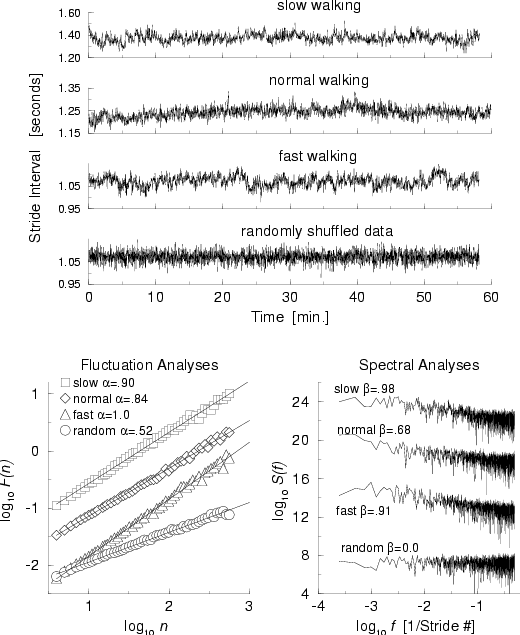Unconstrained and Metronomic Walking

Fractal dynamics were recently detected in the apparently “noisy” variations in the stride interval of human walking. Dynamical analysis of these step-to-step fluctuations revealed a self-similar pattern: fluctuations at one time scale are statistically similar to those at multiple other time scales, at least over hundreds of steps, while healthy subjects walk at their normal rate. To study the stability of this fractal property, we analyzed data obtained from ten healthy subjects who walked for 1 hour at their usual, slow and fast paces. The stride interval fluctuations exhibited long-range correlations with power-law decay for up to a thousand strides at all three walking rates. In contrast, during metronomically-paced walking, these long-range correlations disappeared; variations in the stride interval were anti-correlated. The long-range correlations observed during spontaneous walking were not affected by removal of drifts in the time series. Thus, the fractal dynamics of spontaneous stride interval are normally quite robust and intrinsic to the locomotor system. Furthermore, this fractal property of neural output may be related to the higher nervous centers responsible for control of walking rhythm.
Stride interval fluctuations were studied in ten young, healthy men. Participants had no history of any neuromuscular, respiratory or cardiovascular disorders, and were taking no medications. Mean age was 21.7 years (range: 18-29 years). Height was 1.77 ± 0.08 meters (mean ± S.D.) and weight was 71.8 ± 10.7 kg. All subjects provided informed written consent.
Subjects walked continuously on level ground around an obstacle free, long (either 225 or 400 meters), approximately oval path and the stride interval was measured using ultra-thin, force sensitive switches taped inside one shoe. For more details, please see the accompanying publication.
Each subject was given an arbitrary id (si01, si02, ... si10). For each subject, there are six data files: normal (.norm), slow (.slow) and fast (.fast) walking for 1 hour each as well as walking in time to a metronome at normal (.metnrm), slow (.metslw) and fast (.metfst) paces.
We find robust long-range correlations during unconstrained walking at all three walking rates and anti-correlations during metronomic walking. What do you find? Are there other rate or condition dependent effects on the histogram or the dynamics?
For more information, please see:
or contact Jeff Hausdorff.
Name Last modified Size Description
Parent Directory -
DOI 19-Feb-2019 19:53 19
MD5SUMS 13-Jul-2005 08:27 2.8K
local.css 28-Oct-2015 23:02 3.1K
SHA1SUMS 13-Jul-2005 08:27 3.3K
SHA256SUMS 18-Sep-2007 18:40 4.9K
si08.metslw 18-Jan-2001 00:47 7.1K
si05.metslw 18-Jan-2001 00:47 7.7K
si03.metslw 18-Jan-2001 00:47 8.0K
si10.metslw 18-Jan-2001 00:47 8.1K
si09.metslw 18-Jan-2001 00:47 8.3K
si07.metslw 18-Jan-2001 00:47 8.3K
si04.metslw 18-Jan-2001 00:47 8.3K
si06.metfst 18-Jan-2001 00:47 8.4K
si08.metnrm 18-Jan-2001 00:47 8.4K
si01.metslw 18-Jan-2001 00:47 8.8K
si10.metnrm 18-Jan-2001 00:47 9.0K
si09.metnrm 18-Jan-2001 00:47 9.2K
si05.metnrm 18-Jan-2001 00:47 9.3K
si10.metfst 18-Jan-2001 00:47 9.4K
si06.metnrm 18-Jan-2001 00:47 9.6K
si01.metnrm 18-Jan-2001 00:47 9.7K
si03.metnrm 18-Jan-2001 00:47 9.7K
si09.metfst 18-Jan-2001 00:47 9.9K
si04.metnrm 18-Jan-2001 00:47 10K
si02.metslw 18-Jan-2001 00:47 10K
si07.metfst 18-Jan-2001 00:47 10K
si07.metnrm 18-Jan-2001 00:47 10K
si06.metslw 18-Jan-2001 00:47 10K
si02.metfst 18-Jan-2001 00:47 10K
si08.metfst 18-Jan-2001 00:47 10K
si02.metnrm 18-Jan-2001 00:47 11K
si01.metfst 18-Jan-2001 00:47 11K
si04.metfst 18-Jan-2001 00:47 11K
si03.metfst 18-Jan-2001 00:47 11K
si05.metfst 18-Jan-2001 00:47 11K
si08.slow 18-Jan-2001 00:47 12K
si05.slow 18-Jan-2001 00:47 15K
si10.slow 18-Jan-2001 00:47 15K
si04.slow 18-Jan-2001 00:47 15K
si07.slow 18-Jan-2001 00:47 16K
si09.slow 18-Jan-2001 00:47 16K
si06.slow 18-Jan-2001 00:47 17K
si08.norm 18-Jan-2001 00:47 17K
si07.norm 18-Jan-2001 00:47 17K
si10.norm 18-Jan-2001 00:47 17K
si09.norm 18-Jan-2001 00:47 18K
si04.norm 18-Jan-2001 00:47 18K
si03.fast 18-Jan-2001 00:47 19K
si10.fast 18-Jan-2001 00:47 19K
si06.norm 18-Jan-2001 00:47 19K
si01.slow 18-Jan-2001 00:47 19K
si02.slow 18-Jan-2001 00:47 20K
si02.norm 18-Jan-2001 00:47 20K
si05.norm 18-Jan-2001 00:47 20K
si01.norm 18-Jan-2001 00:47 20K
si03.norm 18-Jan-2001 00:47 20K
si07.fast 18-Jan-2001 00:47 20K
si09.fast 18-Jan-2001 00:47 20K
si06.fast 18-Jan-2001 00:47 20K
si03.slow 18-Jan-2001 00:47 21K
si04.fast 18-Jan-2001 00:47 21K
si01.fast 18-Jan-2001 00:47 21K
si08.fast 18-Jan-2001 00:47 22K
si05.fast 18-Jan-2001 00:47 22K
si02.fast 18-Jan-2001 00:47 22K
fig.png 16-Aug-2001 20:35 37K
fig.ps 16-Aug-2001 20:33 281K
|
If you would like help understanding, using, or downloading content, please see our Frequently Asked Questions. If you have any comments, feedback, or particular questions regarding this page, please send them to the webmaster. Comments and issues can also be raised on PhysioNet's GitHub page. Updated Friday, 28-Oct-2016 22:58:42 CEST |
PhysioNet is supported by the National Institute of General Medical Sciences (NIGMS) and the National Institute of Biomedical Imaging and Bioengineering (NIBIB) under NIH grant number 2R01GM104987-09.
|